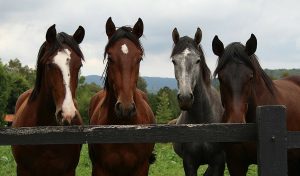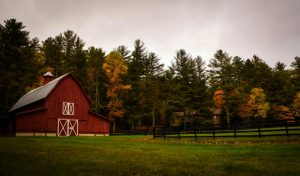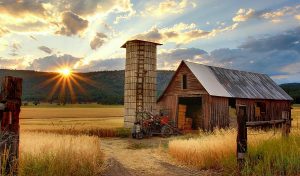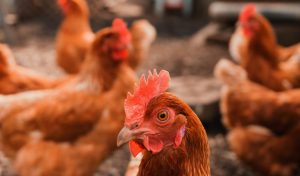How To Maintain Farm Structures and Buildings: Farm structures and buildings provide suitable environment for establishing a prosperous farm. They are essential and part of the branches of agricultural engineering. Farm structures are also known as farm buildings. These structures which make the farm work effective should not be neglected and allowed to waste.
Recommended: Most profitable skills to learn in 2022
Types Of Farm Structures and Buildings
There are so many things used for different types of purposes. Some of these could be used as homes for the farmers, their staffs, and family. Some farm structures could be used to keep livestock, crops, and all types of equipments.

a. Barn: A barn is a popular type of farm structures as it contributes immensely to the farm. A barn could be used for a number of reasons which ranges from providing shelter for farm animals to a number of things like storing seeds like grains, hay, etc, storing supplies and machines.
b. Farm Houses: Just as the name implies is a building for farmers, their families, and their workers to live in while at the farm. Sometimes, it may be attached to a barn. A farm house includes a space or place for an office, a reasonable space to sleep in and a place to store food. It’s a sophisticated building which would have most of the necessities needed at home, has a refrigerator with a cellar or a freezer.

The reason for this is because, most of this farm houses is built as a permanent houses for these farmers and families and it’s mostly found in rural places, which serves as a base for agricultural activities. A large farm house could contain three to four bedrooms or even more. A farm house is primarily the quarter for agricultural settings.
Also see: Farmer vs Doctors, Who are more important in the society? Answered
c. Silo: When we hear the word silo, what comes to our mind is storage. Well we are not mistaken as silo is a storage facility used in storing foods like rice, corn, coal, cements, sawdust, etc.
d. Brooder House: A brooder house is an enclosure which is in form of a small building, which is heated to provide shelter for young livestock and poultry. It is majorly used for raising baby birds like goslings, turkey poults, and baby chicks.

These animals naturally rely on their mothers to keep them warm as they are unable to do so by themselves, but in a situation where their mother is absent, the brooder house provides them with the required heat which they need to keep them warm and ease off the stress on their internal organs thereby keeping them warm as long as they so require.
A brooder house is required and must have ventilation, warmth, hydration, and sanitation in other to keep the livestock alive and healthy. However, a large brooder house like a commercial brooder house would also have other things like fan ventilation, heat lamps, large doors and automatic feeders.
Recommended: Types/Forms of Agriculture
e. Chicken House: A chicken house as the name goes is a house built for chickens. It is also known as a chicken coop. A chicken house is a small building or structure normally used for keeping chickens especially the female chickens as it is of more benefit to them.
A chicken coop is normally constructed in other to have a place where the chicken could lay an egg and have the owner harvest the eggs and also to protect the already laid eggs from bad weather. It is a save zone for chickens where they can grow, flourish and be their chicken selves.
f. Greenhouse: Greenhouse, when we here they word greenhouse the first thing that comes to our minds is a house that is green but it is not the case here. A greenhouse is an agricultural facility which is unique and it is helpful in growing crops and plants which requires regulated weather condition. The walls and the roofs of a greenhouse are usually built in glass and transparent materials. Majority of a greenhouse building always have a built in window which is used for ventilation.
A glasshouse is an optional greenhouse structure which is used for producing vegetables, flowers of fruits in cold or mid-cold climates. Greenhouses made of polythene and poly-tunnels are most suitable in the growth of nursery and in the production of vegetables and flowers in any form of climate. Also, net houses are always cost effective in production and they are always ideal for the cultivation of crops which include orchards, tree-crop nurseries, and vegetables.
Recommended: Ways of promoting popular participation in politics
g. Milking Shed: A milking shed is a shed like building which is being constructed for the sole purpose of milking farm animals. This shed is always sanitized and it meets up with the hygienic standard used for milking. This form of farm structure is always important for places where the milk is not pasteurized.
h. Root Cellar: This form of farm structure is not a very common type of farm structure in this modern day. This is an underground facility used in storing fruits, vegetables and other kinds of food. It is always helpful in places with cold weather or in winters, thereby making foods and vegetables fresh during the cold weather.

Recommended: Advantages and Disadvantages of being self employed
How To Maintain Farm Structures and Buildings
Working in the farm requires a lot of dedication and care. Farm structures needs to be maintained in other for it to withstand the test of time and stay for a number of years before it becomes old and unable to be used. There are so many ways in which a farm structure could be maintained, they are:
1. Farm structures are mostly built with wood; therefore, all wooden parts of the farm structures should be painted with solignum or with coal tar in order to prevent termites from infesting the wood.
2. When the roof starts leaking it is required that it be fixed to avoid further damage both on the roof and on the stored food or farm equipments.
Also see: Two (2) Major Types of Agriculture
3. All metal part of the farm structures should be painted delicately in other to prevent rusting as a result of friction and expositor to the sun.
4. Floors should be regularly inspected and floor boards maintained and swept regularly. Floors on the upper stories of the farm structures should be checked regularly for weak or rotten sports on them.
5. Silos built with iron should be coated with paint (aluminum paint) in other to prevent it from rusting and reflect light. All metal which is damaged, should be replaced.
6. Farm dams and ponds should occasionally be dredged so as to always maintain a reasonable water level.
7. Moving parts of the engines, farm tool, farm equipments, and farm structures should always be lubricated especially at their moving parts, metals, bolts, joints, to prevent rust and friction.
Recommended: Best science courses to study in the university
8. Built up trash, dust, cobwebs which could interfere with the electrical systems of the farm structures and cause damage as a result, should always be cleared and cleaned up to prevent unforeseen consequences.
9. Parts or areas where there is frequent passage like the stairs should be rid of objects which could cause one to trip and fall. Also, avoid the urge to create piles of objects which could attract children or domestic animals to climb and in return, get themselves injured.
Also see: Best Countries for Master’s degree program
10. Storage of chemicals should be done correctly, empty cans of chemicals should be disposed of properly, pesticides, and herbicides should be locked up and kept safe in a cool dry place. All chemicals should be kept out of the reach of children and house hold pets.

Edeh Samuel Chukwuemeka, ACMC, is a lawyer and a certified mediator/conciliator in Nigeria. He is also a developer with knowledge in various programming languages. Samuel is determined to leverage his skills in technology, SEO, and legal practice to revolutionize the legal profession worldwide by creating web and mobile applications that simplify legal research. Sam is also passionate about educating and providing valuable information to people.
Thanks
Hi sign up for ezoic –
Good report